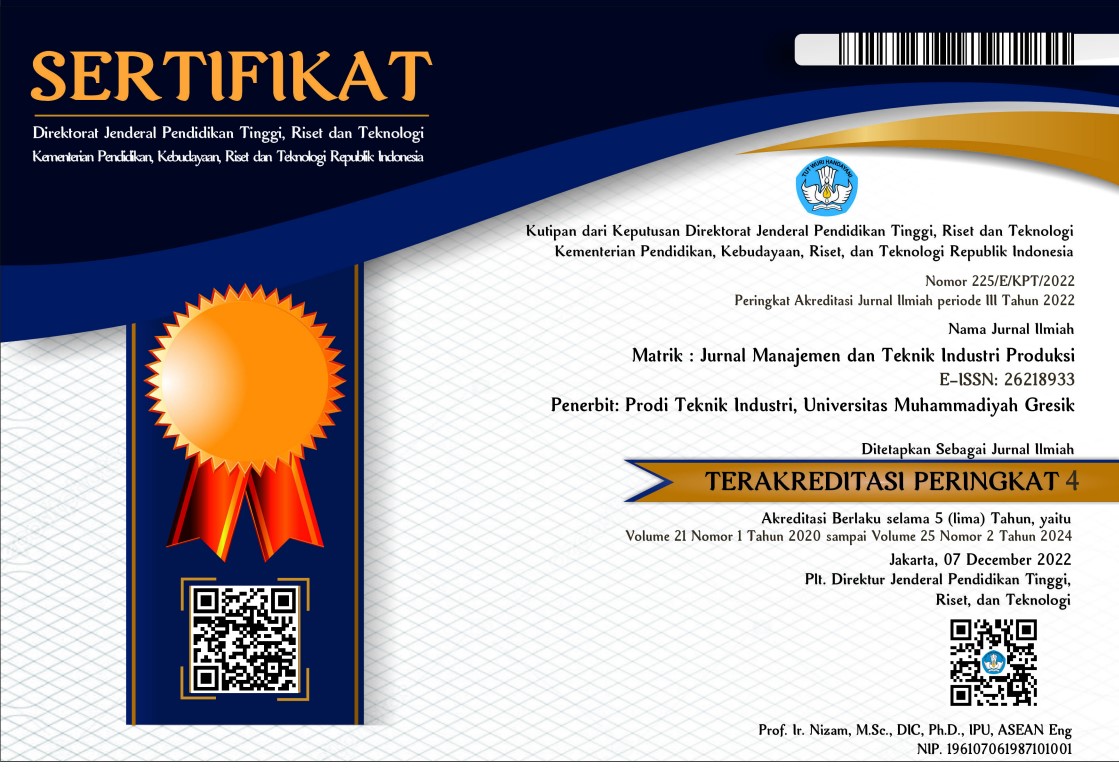Implementasi Perbaikan Proses Produksi Air Bersih di Instalasi Pengolahan Air Minum
DOI:
https://doi.org/10.30587/matrik.v24i1.4152Keywords:
LCA, QFD, instalasi pengolahan air minum,Abstract
Keterbatasan sumber daya air, meningkatnya permintaan air, dan polusi sumber daya air menjadi tugas besar yang perlu di pikirkan oleh Instalasi Pengolahan Air Minum (IPAM). Metode sistematis untuk mengidentifikasi, mengukur, dan menilai aspek dan dampak potensial lingkungan melalui seluruh siklus hidup suatu produk, proses atau aktivitas dapat menggunakan metode Life Cycle Assessment (LCA). Analisis dampak lingkungan yang dihasilkan dari metode LCA dapat menjadi masukan dalam melakukan perbaikan kualitas pengolahan air bersih dari segi lingkungan. Salah satu metode perbaikan kualitas adalah Quality Function Deployment (QFD). penelitian ini bermaksud mengimplementasikan perbaikan yang perlu dilakukan oleh pihak IPAM Babat dalam mengurangi potensi pencemaran lingkungan serta memanfaatkan kembali limbah dari pengolahan IPAM. Perbaikan yang telah diterapkan selanjutnya dianalisis menggunakan LCA untuk mengetahui dampak lingkungan yang ditimbulkan dan membandingkan besar dampak lingkungan sebelum dan setelah perbaikan diimplementasikan. Keseluruhan dampak mengalami penurunan nilai setelah dilakukan pencampuran air lumpur buangan pada proses produksi air bersih selama 30 menit. Hal ini menunjukkan bahwa dalam menghasilkan 1 kg air bersih dengan pengolahan kembali air lumpur buangan dapat mengurangi dampak fossil fuels, carcinogens, respiratory organics, respiratory inorganics, climate change, radiation, ozone layer, excotoxity, acidification/eutropication, land use, dan minerals.
References
[2] D. Ghernaout, “Disinfection By-Products: Presence and Elimination in Drinking Water,” OALib, vol. 07, no. 02, pp. 1–27, 2020, doi: 10.4236/oalib.1106140.
[3] M. C. Collivignarelli, A. Abbà, I. Benigna, S. Sorlini, and V. Torretta, “Overview of the main disinfection processes for wastewater and drinking water treatment plants,” Sustain., vol. 10, no. 1, pp. 1–21, 2018, doi: 10.3390/su10010086.
[4] Y. Zhang, M. Sivakumar, S. Yang, K. Enever, and M. Ramezanianpour, “Application of solar energy in water treatment processes: A review,” Desalination, vol. 428, no. November 2017, pp. 116–145, 2018, doi: 10.1016/j.desal.2017.11.020.
[5] M. Molinos-Senante and R. Sala-Garrido, “Energy intensity of treating drinking water: Understanding the influence of factors,” Appl. Energy, vol. 202, pp. 275–281, 2017, doi: 10.1016/j.apenergy.2017.05.100.
[6] I. Kristiana, D. Liew, R. K. Henderson, C. A. Joll, and K. L. Linge, “Formation and control of nitrogenous DBPs from Western Australian source waters: Investigating the impacts of high nitrogen and bromide concentrations,” J. Environ. Sci. (China), vol. 58, pp. 102–115, 2017, doi: 10.1016/j.jes.2017.06.028.
[7] A. Facchini, C. Kennedy, I. Stewart, and R. Mele, “The energy metabolism of megacities,” Appl. Energy, vol. 186, no. 2017, pp. 86–95, 2017, doi: 10.1016/j.apenergy.2016.09.025.
[8] T. Ahmad, K. Ahmad, and M. Alam, “Characterization of Water Treatment Plant’s Sludge and its Safe Disposal Options,” Procedia Environ. Sci., vol. 35, pp. 950–955, 2016, doi: 10.1016/j.proenv.2016.07.088.
[9] K. Kołecka, M. Gajewska, H. Obarska-Pempkowiak, and D. Rohde, “Integrated dewatering and stabilization system as an environmentally friendly technology in sewage sludge management in Poland,” Ecol. Eng., vol. 98, pp. 346–353, 2017, doi: 10.1016/j.ecoleng.2016.08.011.
[10] C. Cherchi, M. Badruzzaman, J. Oppenheimer, C. M. Bros, and J. G. Jacangelo, “Energy and water quality management systems for water utility’s operations: A review,” J. Environ. Manage., vol. 153, pp. 108–120, 2015, doi: 10.1016/j.jenvman.2015.01.051.
[11] D. Y. Irawati and D. Andrian, “Analisa Dampak Lingkungan Pada Instalasi Pengolahan Air Minum (IPAM) Dengan Metode Life Cycle Assessment (LCA),” J. Tek. Ind., vol. 19, no. 2, pp. 166–177, 2018, doi: 10.22219/jtiumm.vol19.no2.166-177.
[12] M. M. Maroneze, L. Q. Zepka, J. G. Vieira, M. I. Queiroz, and E. Jacob-Lopes, “A tecnologia de remoção de fósforo: Gerenciamento do elemento em resíduos industriais,” Rev. Ambient. e Agua, vol. 9, no. 3, pp. 445–458, 2014, doi: 10.4136/1980-993X.
[13] G. Bârjoveanu, C. Teodosiu, A. F. Gîlcă, I. Roman, and S. Fiore, “Environmental performance evaluation of a drinking water treatment plant: A life cycle assessment perspective,” Environ. Eng. Manag. J., vol. 18, no. 2, pp. 513–522, 2019, doi: 10.30638/eemj.2019.048.
[14] M. Garfí, E. Cadena, D. Sanchez-Ramos, and I. Ferrer, “Life cycle assessment of drinking water: Comparing conventional water treatment, reverse osmosis and mineral water in glass and plastic bottles,” J. Clean. Prod., vol. 137, pp. 997–1003, 2016, doi: 10.1016/j.jclepro.2016.07.218.
[15] M. Garfí, L. Flores, and I. Ferrer, “Life Cycle Assessment of wastewater treatment systems for small communities: Activated sludge, constructed wetlands and high rate algal ponds,” J. Clean. Prod., vol. 161, pp. 211–219, 2017, doi: 10.1016/j.jclepro.2017.05.116.
[16] Y. Klochkov, E. Klochkova, A. Volgina, and S. Dementiev, “Human factor in quality function deployment,” Proc. - 2nd Int. Symp. Stoch. Model. Reliab. Eng. Life Sci. Oper. Manag. SMRLO 2016, pp. 466–468, 2016, doi: 10.1109/SMRLO.2016.81.
[17] L. D. Robescu, C. Silivestru, A. Presura, A. Pana, and R. Mihai, “Application of Continuous Improvement Strategy for reducing environmental impact of a wastewater treatment plant Application of Continuous Improvement Strategy environmental impact of a wastewater treatment plant for reducing improving wastewater treatmen,” no. January 2016, pp. 29–40, 2019.
[18] Y. Ramírez, L. A. Cisternas, and A. Kraslawski, “Application of House of Quality in assessment of seawater pretreatment technologies,” J. Clean. Prod., vol. 148, pp. 223–232, 2017, doi: 10.1016/j.jclepro.2017.01.163.
[19] D. Adrian and D. Y. Irawati, “Rencana perbaikan proses produksi air bersih dengan pendekatan life cycle assesment (lca) dan quality function deployment (qfd) di instalasi pengolahan air minum babat,” Semin. Nas. VII Manaj. Rekayasa Kualitas, pp. 1–6, 2018.
[20] ISO, “ISO 14040: Environmental Management--Life Cycle Assessment--Principles and Famework,” Geneva, 2006.
[21] ISO, “ISO 14044: Environmental Management--Life Cycle Assessment--Requirement and Guidelines,” 2006.
[22] M. Tabesh, M. Feizee Masooleh, B. Roghani, and S. S. Motevallian, “Life-Cycle Assessment (LCA) of Wastewater Treatment Plants: A Case Study of Tehran, Iran,” Int. J. Civ. Eng., vol. 17, no. 7, pp. 1155–1169, 2019, doi: 10.1007/s40999-018-0375-z.
[23] S. J. Kenway and K. L. Lam, “Quantifying and managing urban water-related energy use systemically: case study lessons from Australia,” Int. J. Water Resour. Dev., vol. 32, no. 3, pp. 379–397, 2016, doi: 10.1080/07900627.2015.1132195.
[24] D. Panepinto, S. Fiore, M. Zappone, G. Genon, and L. Meucci, “Evaluation of the energy efficiency of a large wastewater treatment plant in Italy,” Appl. Energy, vol. 161, pp. 404–411, 2016, doi: 10.1016/j.apenergy.2015.10.027.
[25] X. Li, J. Liu, C. Zheng, G. Han, and H. Hoff, “Energy for water utilization in China and policy implications for integrated planning,” Int. J. Water Resour. Dev., vol. 32, no. 3, pp. 477–494, 2016, doi: 10.1080/07900627.2015.1133403.
[26] M. Wakeel, B. Chen, T. Hayat, A. Alsaedi, and B. Ahmad, “Energy consumption for water use cycles in different countries: A review,” Appl. Energy, vol. 178, no. 19, pp. 868–885, 2016, doi: 10.1016/j.apenergy.2016.06.114.
[27] G. McNamara et al., “Life cycle assessment of wastewater treatment plants in Ireland,” J. Sustain. Dev. Energy, Water Environ. Syst., vol. 4, no. 3, pp. 216–233, 2016, doi: 10.13044/j.sdewes.2016.04.0018.
[28] K. A. Adeniran and I. D. Dunmoye, “Relative Coagulation Potentials of Aluminum Sulphate and Mangifera indica Seeds in Purifying Domestic Waste Water,” Kathmandu Univ. J. Sci. Eng. Technol., vol. 13, no. 2, pp. 26–38, 2018, doi: 10.3126/kuset.v13i2.21281.
[29] V. M. Oliveira et al., “Aluminium sulfate exposure: A set of effects on hydrolases from brain, muscle and digestive tract of juvenile Nile tilapia (Oreochromis niloticus),” Comp. Biochem. Physiol. Part - C Toxicol. Pharmacol., vol. 191, pp. 101–108, 2017, doi: 10.1016/j.cbpc.2016.10.002.
[30] J. Chang, W. Lee, and S. Yoon, “Energy consumptions and associated greenhouse gas emissions in operation phases of urban water reuse systems in Korea,” J. Clean. Prod., vol. 141, no. 2017, pp. 728–736, 2017, doi: 10.1016/j.jclepro.2016.09.131.
[31] K. Smith, S. Liu, and T. Chang, “Contribution of Urban Water Supply to Greenhouse Gas Emissions in China,” J. Ind. Ecol., vol. 20, no. 4, pp. 792–802, 2016, doi: 10.1111/jiec.12290.
[32] E. Fosso-Kankeu, A. Webster, I. O. Ntwampe, and F. B. Waanders, “Coagulation/Flocculation Potential of Polyaluminium Chloride and Bentonite Clay Tested in the Removal of Methyl Red and Crystal Violet,” Arab. J. Sci. Eng., vol. 42, no. 4, pp. 1389–1397, 2017, doi: 10.1007/s13369-016-2244-x.
[33] S. Pandey, “A comprehensive review on recent developments in bentonite-based materials used as adsorbents for wastewater treatment,” J. Mol. Liq., vol. 241, pp. 1091–1113, 2017, doi: 10.1016/j.molliq.2017.06.115.
[34] S. Ranga, “Bentonite used as natural coagulant and adsorbent: A review Sweety Ranga,” ~ 155 ~ Pharma Innov. J., vol. 7, no. 7, pp. 155–157, 2018, [Online]. Available: www.thepharmajournal.com







